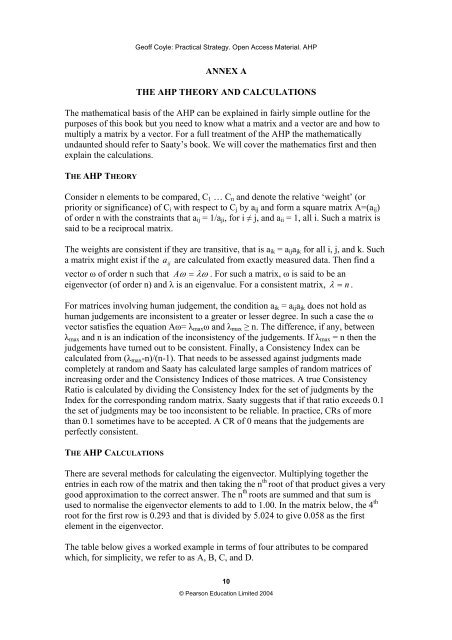THE ANALYTIC HIERARCHY PROCESS (AHP)
THE ANALYTIC HIERARCHY PROCESS (AHP)
THE ANALYTIC HIERARCHY PROCESS (AHP)
You also want an ePaper? Increase the reach of your titles
YUMPU automatically turns print PDFs into web optimized ePapers that Google loves.
Geoff Coyle: Practical Strategy. Open Access Material. <strong>AHP</strong><br />
ANNEX A<br />
<strong>THE</strong> <strong>AHP</strong> <strong>THE</strong>ORY AND CALCULATIONS<br />
The mathematical basis of the <strong>AHP</strong> can be explained in fairly simple outline for the<br />
purposes of this book but you need to know what a matrix and a vector are and how to<br />
multiply a matrix by a vector. For a full treatment of the <strong>AHP</strong> the mathematically<br />
undaunted should refer to Saaty’s book. We will cover the mathematics first and then<br />
explain the calculations.<br />
<strong>THE</strong> <strong>AHP</strong> <strong>THE</strong>ORY<br />
Consider n elements to be compared, C1 … Cn and denote the relative ‘weight’ (or<br />
priority or significance) of Ci with respect to Cj by aij and form a square matrix A=(aij)<br />
of order n with the constraints that aij = 1/aji, for i ≠ j, and aii = 1, all i. Such a matrix is<br />
said to be a reciprocal matrix.<br />
The weights are consistent if they are transitive, that is aik = aijajk for all i, j, and k. Such<br />
a matrix might exist if the a ij are calculated from exactly measured data. Then find a<br />
vector ω of order n such that Aω = λω . For such a matrix, ω is said to be an<br />
eigenvector (of order n) and λ is an eigenvalue. For a consistent matrix, λ = n .<br />
For matrices involving human judgement, the condition aik = aijajk does not hold as<br />
human judgements are inconsistent to a greater or lesser degree. In such a case the ω<br />
vector satisfies the equation Aω= λmaxω and λmax ≥ n. The difference, if any, between<br />
λmax and n is an indication of the inconsistency of the judgements. If λmax = n then the<br />
judgements have turned out to be consistent. Finally, a Consistency Index can be<br />
calculated from (λmax-n)/(n-1). That needs to be assessed against judgments made<br />
completely at random and Saaty has calculated large samples of random matrices of<br />
increasing order and the Consistency Indices of those matrices. A true Consistency<br />
Ratio is calculated by dividing the Consistency Index for the set of judgments by the<br />
Index for the corresponding random matrix. Saaty suggests that if that ratio exceeds 0.1<br />
the set of judgments may be too inconsistent to be reliable. In practice, CRs of more<br />
than 0.1 sometimes have to be accepted. A CR of 0 means that the judgements are<br />
perfectly consistent.<br />
<strong>THE</strong> <strong>AHP</strong> CALCULATIONS<br />
There are several methods for calculating the eigenvector. Multiplying together the<br />
entries in each row of the matrix and then taking the n th root of that product gives a very<br />
good approximation to the correct answer. The n th roots are summed and that sum is<br />
used to normalise the eigenvector elements to add to 1.00. In the matrix below, the 4 th<br />
root for the first row is 0.293 and that is divided by 5.024 to give 0.058 as the first<br />
element in the eigenvector.<br />
The table below gives a worked example in terms of four attributes to be compared<br />
which, for simplicity, we refer to as A, B, C, and D.<br />
10<br />
© Pearson Education Limited 2004


